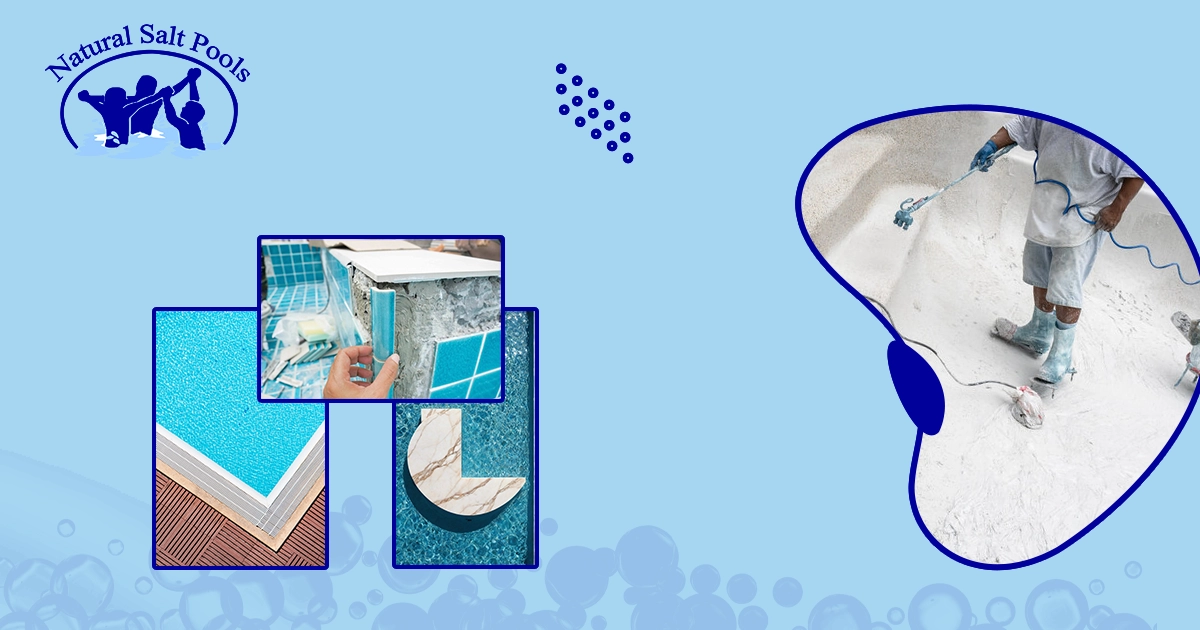Transforming your pool with modern resurfacing techniques can breathe new life into an old or worn-out pool, enhancing both its aesthetic appeal and functionality. Modern pool resurfacing techniques not only make your pool look new but also extend its lifespan with a wonderful way to add value and enjoyment to the pool. By selecting materials and finishes that align with your style preferences and maintenance capabilities, you can enjoy pool renovation ideas and a beautiful pool for years to come. Here are some popular pool renovation ideas:
- Aggregate finishes: These include exposed aggregate and pebble finishes. They provide a textured surface that’s both durable and aesthetically pleasing, with a range of colors and materials to choose from. The rough texture also enhances traction, making it a safer option for pool areas.
- Fiberglass resurfacing: This method involves applying a layer of fiberglass over the existing surface. It’s highly durable, resistant to stains, and offers a smooth, glossy finish. Fiberglass is also non-porous, which helps to prevent algae growth and reduce maintenance costs.
- Plaster resurfacing: Often using a high-quality mix, traditional plaster resurfacing offers a classic appearance and allows for custom color tinting. It’s smooth and can last 7-10 years before needing replacement. This type of resurfacing is cost-effective and widely popular due to its straightforward application process.
- Tile resurfacing: Adding tiles, such as ceramic, glass, or mosaic, can give your pool a luxurious and unique appearance. Tiles are also highly durable and simple to clean. They are resistant to chemical damage, making them ideal for long-term use in chlorinated pools.
- Quartz resurfacing: This technique uses a blend of quartz aggregates and a cement-based binder. It has a modern look and comes in a variety of colors, making it more resistant to staining and etching. Quartz is also UV resistant, helping maintain the color and integrity of the pool surface even under intense sunlight.
- Vinyl liners: For a cost-effective alternative to plaster or tile, vinyl liners are a good choice. They come in various patterns and colors and are relatively simple to install and replace. Vinyl liners are smooth to the touch, which can be more comfortable for swimmers and less abrasive on the skin.

Exploring the Latest Materials and Methods for Pool Resurfacing.
Exploring the latest materials and methods for advanced pool resurfacing materials can help you choose the best option to rejuvenate your pool’s appearance, improve durability, and enhance its overall experience. Here are some of the most recent advancements in pool resurfacing materials and techniques:
- Exposed aggregate finishes: This resurfacing method involves embedding tiny pieces of glass, quartz, or pebbles into the pool’s concrete surface. After curing, homeowners wash away the top layer to expose the embedded materials, resulting in a textured and visually appealing finish. It is highly durable and slip-resistant, making it a popular choice for many homeowners.
- Polished aggregate finishes: Similar to exposed aggregate, polished aggregate finishes use tiny stones or glass beads mixed with plaster. However, polished aggregate finishes polish the surface to create a smooth and shiny appearance, instead of washing away the top layer. This method offers a sophisticated look and feels smooth to the touch while maintaining durability.
- Pebble Tec and Pebble sheen: These are trademarked products known for their superior quality and durability. Pebble Tec incorporates larger pebbles, providing a natural riverbed appearance, while Pebble Sheen uses smaller pebbles for a smoother finish. Both options are available in a range of colors and textures, allowing for customization to suit different aesthetic preferences.
- Glass bead finishes: For pool resurfacing, glass beads are a modern and luxurious option. The beads create a smooth and reflective surface that shimmers underwater, enhancing the pool’s aesthetic appeal. Glass bead finishes exhibit exceptional durability, withstand chemical damage, and facilitate the creation of intricate designs and patterns.
- Quartz aggregate finishes: To create a strong, stain-resistant surface, quartz finishes blend crushed quartz with cement-based plaster. The quartz provides a speckled, colorful appearance and is more durable than standard plaster finishes. This method offers a balance between aesthetics, longevity, and cost-effectiveness, making it a popular choice for many pool owners.
- Polished marble or marble dust finishes: Using crushed marble or marble dust mixed with white cement, these finishes offer a smooth, elegant surface with a classic appeal. The marble reflects light, giving the water a bright, inviting look. While slightly more expensive than traditional plaster, marble finishes are durable and resistant to the growth of algae.
- Eco-finish high-performance coating: This innovative technique uses a flame-sprayed polymer coating that adheres to the pool’s surface, providing a durable and smooth finish. Eco-Finish is resistant to staining, chipping, and fading, and it is available in a wide range of colors. It’s also eco-friendly, as it doesn’t contain harmful chemicals and has a rapid installation process.


Leave a Reply